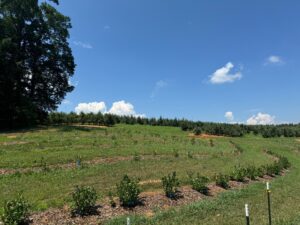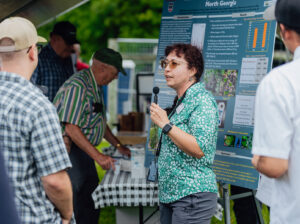Progress report for OS24-173
Project Information
Since 2020, we have been conducting research on Aronia ‘Viking’ (most widely planted cultivar) in Georgia. We found that it only sets berries in the northern parts of the state likely due to its chill requirement7 in order to obtain fruit in sufficient quantity for commercial production. Replicated plantings of three-year old plants at the UGA MREC Blairsville and UGA-Griffin have generated data on plant growth, berry yield, and fruit quality8. Fruit quality of ‘Viking’ in Blairsville (USDA Zone 7a, Blue Ridge region) and Griffin (USDA Zone 8a, Piedmont region) for 2022 and 2023 were as follows. In 2022, plants in Blairsville had higher yield on average (237 berries/plant with 184 g/plant for ‘Viking’; 1,085.7 berries/plant) compared to plants in Griffin (119 berries/plant with 38 g/plant for ‘Viking’). The same trend was observed in berry weight and diameter. Blairsville berries were sweeter than berries in Griffin. ‘Viking’ berries in Griffin had tougher skins (4.5 N) compared to berries in Blairsville. We attribute these differences in fruit quality to environmental conditions, specifically temperature. In 2023, plants in Blairsville yielded 1,310 berries per bush, an increase of 550% over the previous year. The yield per bush was 1.55 lbs. In 2023, ‘Viking’ berries harvested in Blairsville were less acidic (0.34 total titratable acidity, TTA) than in 2022 (0.44 TTA), and less sweet (23.2° Brix) than in 2022 (26.0° Brix). The fruit quality from northern areas of production reported values of 13.6-14.5° Brix and 0.9-1.08 TA (titratable acidity)9. From this data we could draw initial inference that Georgia-grown aroniaberry may be superior to northern-grown due to its higher sugar content. Fruit flavor encompasses a combination of factors such as aroma, texture, and sugar/acid ratios10.
In fall of 2023, we established a planting of 120 aronias at Mercier Orchards, a 300-acre orchard located in Blue Ridge, GA. This project will follow up plant growth and performance to determine yield, berry properties, identify potential production issues, develop enterprise budget, and disseminate results to producers. We also plan to investigate optimal irrigation and fertilization regimes for aronia. So far, we have achieved excellent survival rates (97 - 99%) with irrigation only at planting/first two weeks afterwards. It is logical to assume that productivity would be higher with supplemental irrigation. Careful consideration also should be given to fertilization because it could affect fruit quality11. For example, maximum production of anthocyanins per plant was obtained with a medium high fertilizer rate (50 kg N/ha, 44 kg P/ha, 100 kg K/ha = 20.24 kg N/A), although higher rate resulted in higher yield and larger plants12. So far in our plantings, we have applied small amount of fertilizer at planting (25 g N/plant).
New for 2024: Plants have established very well. A protective deer fence has been installed. Aphids and Japanese beetles were observed on the foliage, however, none caused significant damage. In May and in July of 2024, we applied the following fertilizer treatments: 0 (UTC), 6, 12, or 18 grams of N per plant. Preliminary vegetative data indicate that the fertilized plants responded to the increased nutrition with higher growth. First year flowering will be observed in May of 2025.
We aim to generate on-farm data that would inform on cultivation of aroniaberry, and diversify market offerings of high-nutraceutical, profitable, alternative crop in Georgia.
We will achieve our objectives by building on our current research and utilizing existing relationships with collaborating farmers, as well as Extension agents. This will be conducted over two years. Fruit data from two growing seasons will be collected.
Objective 1: Determine optimal irrigation and fertilization regimes for aroniaberry.
- We will use the following treatments: two irrigation levels (irrigated and non-irrigated control), and three fertilizer rates (10, 20, or 30 kg N/Acre and untreated control). The experimental design will be split-plot, with irrigation the main plot and fertilization rate the sub-plot. This part will be conducted at Mercier Orchards, where plants have been established in fall of 2023.
Objective 2: Determine fruit yield and berry properties (i.e. texture, sugar content, anthocyanin content, content of brown compounds, content of soluble solids, anthocyanin composition and total acidity, mineral nutrient content).
- Fruit will be harvested from the two farms to determine yield per plant. Representative sample will be processed in the lab according to standard fruit testing protocols for texture (puncture and Kramer shear) and chemical analyses, e.g. 0 Brix (sugar content), titrator (TA), monomeric anthocyanins (AOAC pH differential method). Berry mineral content (nitrogen, phosphorus, potassium, calcium, magnesium, iron, zinc) will also be determined.
Objective 3: Identify potential production issues with aroniaberry.
- We will monitor the crop for foliar and berry problems, pests and diseases, and/or nutritional disorders. If needed, samples will be sent to pathology and entomology labs to determine pest identification.
Objective 4: Determine revenue potential of aroniaberry and develop enterprise budget.
- For both years, we will follow with the two farmers to record all inputs, including materials and labor. After the crop is harvested and marketed (at existing retail location at Mercier farm), we will note quantity sold and revenue generated. In consultation with an ag economist, we will develop an enterprise budget.
Objective 5: Disseminate information on aroniaberry production to producers in north Georgia.
- We will conduct a workshop at the UGA-MREC in Blairsville in August of Year 2 to incorporate observation of mature (5-year old) bushes in the field, and fruit tasting. The workshop will cover all relevant aspects of crop production and include farmers’ perspective. This will present an opportunity to recruit new producers and consumers, and conduct a tasting panel. County agents in the area will be used to promote the event.
Cooperators
- - Producer
Research
We planted 120 aronia Viking liners at Mercier Orchards in Blue Ridge, GA. Plants are protected by a deer fence.
| 0 gr N/plant | 6/gr N/plant | 12 gr N/plant | 18 gr N/plant | |
| Growth Index | 79 | 86 | 91 | 115 |
We measured growth index based on plant height and two widths.
Data from 2024 after two fertilization applications show linear increase in plant growth in response to higher nutrition.
The aronia planting at Mercier Orchard has been established and first treatment of fertilizer has been applied in 2024. Deer fence was installed to protect plants. Plants responded positively to increased fertilizer with respect to vegetative growth. May 2025 is anticipated first blooming of the planting and harvest in July.
Educational & Outreach Activities
Participation Summary:
In 2024, there was a field day at the GMREC in Blairsville. The project leader made presentation which included aronia tasting. Local farmers and community (approximately 90 attendees) heard about nutritional benefits of aronia, progress of aronia project at Mercier. They also observed aronia planting at the GMREC.
A workshop will be conducted at the UGA-MREC in Blairsville in August of Year 2. The attendees will observe mature (5-year old) bushes in the field, and participate in aroniaberry fruit tasting. The workshop will cover all relevant aspects of crop production and include farmers’ perspective. This will present an opportunity to recruit new producers and consumers, and conduct a tasting panel. The event will be promoted using county agents in the area as well as through Georgia Berry Exchange, UGA Blueberry Blog, and the Georgia Farmers and Consumers Market Bulletin.
An extension publication of aronia production will be developed. A presentation will be made at the Southeast Regional Fruit and Vegetable Grower meeting in Savannah. A poster will be presented at the Georgia Farm Bureau Annual Convention (fall 2026, outside grant time frame).
